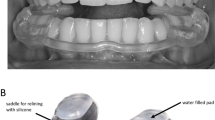Abstract
Objective
Vacuum formed and heat cured acrylic splints have been used in the diagnosis and treatment of temporomandibular disorders. The aim of this study was to evaluate patient’s preference to either the vacuum formed or the heat cured acrylic splint.
Material and methods
Twenty patients planned to receive splints were chosen from the dental school. Both types of occlusal splints were fabricated for each of them. Each patient used the splints alternatively on a nightly basis for 3 weeks. After 3 weeks, each patient completed a questionnaire regarding the comfort, fit, retention, occlusal contact, taste, gingival and lip irritation, smoothness and smelling. Statistical analysis was conducted by the MacNemar’s Chisquare test.
Results
There was no statistical difference in patient’s responses to the different splint materials except for the comfort of wearing through the night.
Conclusion
The vacuum formed and heat cured acrylic splint may be equally worn in patient preference for treatment of temporomandibular disorders.
Similar content being viewed by others
References
Clark GT (1984) A critical evaluation of orthopedic interocclusal appliance therapy: design, theory, and overall effectiveness. J Am Dent Assoc 108(3): 359–364
Ramfjord S, Ash MM (1995) Occlusion. 4th ed, Philadelphia: WB Saunders 363–392
Wagner EP, Crandall SK, Oliver RB. Splints. In: Morgan DH, House LR, Hall WP, Vamvas SJ, eds. (1982) Diseases of the temporomandibular apparatus: a multidisciplinary approach. St Louis: Mosby 265–277
Okeson JP, Kemper JT, Moody PM (1982) A study of the use of occlusion splints in the treatment of acute and chronic patients with craniomandibular disorders. J Prosthet Dent 48(6): 708–712
Okeson JP (1996) Orofacial pain: guidelines for assessment, diagnosis and management. Carol Stream (IL): Quintessence 1–14
Carraro JJ, Caffesse RG (1978) Effects of occlusal splints therapy for specific symptoms of temporomandibular joint dysfunction syndrome. J Prosthet Dent 40(5): 563–566
Dao TT, Lavigne GJ, Charbonneau A, Feine JS, Lund JP (1994) The efficacy of oral splints in the treatment of myofascial pain of the jaw muscles: a controlled clinical trial. Pain 56(1): 85–94
Mikami DB (1977) A review of psychogenic aspects and treatment of bruxism. J Prosthet Dent 37(4): 411–419
Dawson PE (1989) Evaluation, Diagnosis and Treatment of Occlusal Problems. 2nd ed, St Louis: Mosby 457
Major PW, Nebbe B (1997) Use and effectiveness of splint appliance therapy: Review of literature. Cranio 15(2): 159–166
Greene CS, Laskin DM (1972) Splint therapy for the myofascial paindysfunction (MPD) syndrome: a comparative study. J Am Dent Assoc 84(3): 624–628
Suvinen T, Reade P (1989) Prognostic features of value in the management of temporomandibular joint paindysfunction syndrome by occlusal splint therapy. J Prosthet Dent 61(3): 355–361
Lundh H, Westesson PL, Eriksson L, Brooks SL (1992) Temporomandibular joint disk displacement without reduction. Treatment with flat occlusal splint versus no treatment. Oral Surg Oral Med Oral Pathol 73(6): 655–658
Okeson JP (1993) Management of temporomandibular disorders and occlusion. Mosby 467-477
Dworkin SF, Le Resche L (1992) Research diagnostic criteria for temporomandibular disorders: review, criteria, examination and specifications, critique. J Craniomandib Disord 6(4): 301–355
Leib AM (2001) Patient preference for light cured composite bite splint compared to heat cured acrylic bite splint. J Periodontol 72(8): 1108–1112
Capp NJ (1999) Occlusion and splint therapy. Br Dent J 186(5): 217–222
Navarro E, Barghi N, Rey R (1985) Clinical evaluation of maxillary hard and resilient occlusal splints. J Dent Res 64: 313–319
Al-Quran FA, Lyons MF (1999) The immediate effect of hard and soft splints on the EMG activity of the masseter and temporalis muscles. J Oral Rehabil 26(7): 559–563
Dos Santos J Jr, Park JG, Re GJ (2000) Patient preference between visible light cured and heat cured acrylic splints. Am J Dent 13(6): 305–307
Author information
Authors and Affiliations
Corresponding author
Rights and permissions
About this article
Cite this article
Nekora, A., Evlioglu, G., Ceyhan, A. et al. Patient responses to vacuum formed splints compared to heat cured acrylic splints: pilot study. J. Maxillofac. Oral Surg. 8, 31–33 (2009). https://doi.org/10.1007/s12663-009-0008-9
Received:
Accepted:
Published:
Issue Date:
DOI: https://doi.org/10.1007/s12663-009-0008-9




